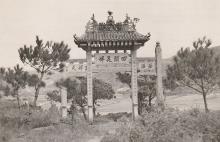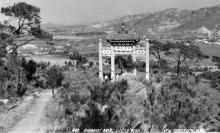From the Antiquities Appraisal Board:
The “Heung Hoi Ming Shan” pai-lau built in 1929 is on the motor road leading to the monastery. It is a symmetrical three-bay four-column structure with a wider central bay to allow access for vehicles and devotees. It is built of reinforced concrete with washed granolithic finishes. Three horizontal flat plaques rest on the beams and a roof is supported by the two middle columns. At the front elevation, the middle plague is engraved with four gilded characters Heung Hoi Ming Shan (香海名山, literally meaning fragrant sea and prestigious Architectural Merit 10 mountain) written by the then Governor Sir Cecil Clementi (金文泰) who had visited the monastery in 1927 and 1928. At the back is another four characters, Wui Tau Shi Nong (回頭是岸, literally meaning repentance is salvation), written by Master Tit Shim (鐵禪法師). Inscriptions are also on the other plaques and columns. The roof is with green glazed pan-and-roll ceramic tiles. The ridge is with Shiwan (石灣) glazed ceramic decorations of two dragon fish locally known as aoyu (鰲魚), opera figurines and geometric pattern made by the Guangzhenxiang (廣禎祥) kiln selected by Wah Chun (華珍) company of Hong Kong.


